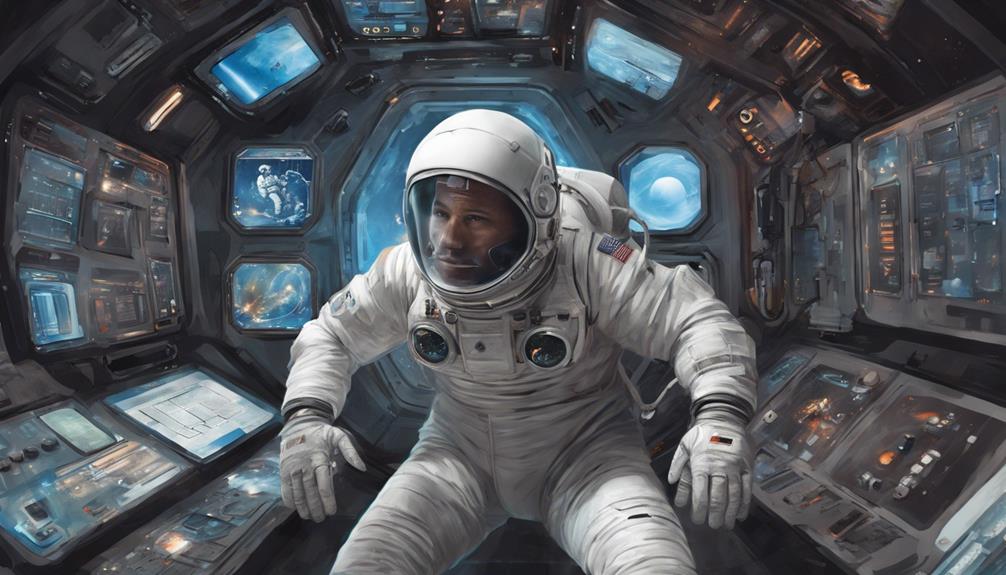Achieving the esteemed title of an astronaut demands a meticulous blend of qualifications and perseverance. From rigorous educational prerequisites to stringent physical evaluations, the journey to space is paved with exacting standards and intense competition. But what lies beyond the initial selection process? How do astronauts prepare for the challenges of space exploration, both mentally and physically? The path to becoming an astronaut is one shrouded in mystery and fascination, offering a glimpse into a world where human capabilities are pushed to their limits.
Key Takeaways
- Meet NASA's stringent criteria: physical fitness, academic excellence, and psychological resilience.
- Obtain STEM bachelor's and master's degrees for space mission readiness.
- Undergo rigorous physical fitness standards and medical evaluations.
- Navigate the astronaut candidate application process through interviews and evaluations for astronaut training selection.
Astronaut Selection Criteria
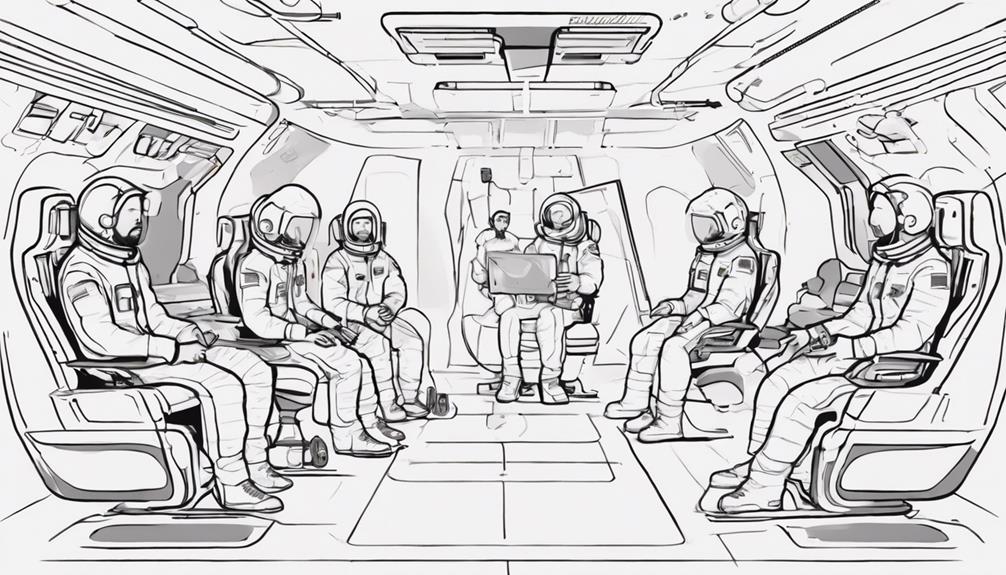
What are the stringent criteria that NASA employs in selecting individuals for astronaut training? NASA's selection process for astronauts is meticulous and thorough, aiming to assemble a diverse and highly qualified team for space missions. Candidates are evaluated based on a combination of physical fitness, academic excellence, and psychological resilience. Key criteria include holding U.S. citizenship, possessing a master's degree in a STEM field, and having relevant professional experience in fields such as engineering, biological science, physical science, or mathematics.
Furthermore, candidates must successfully pass the NASA long-duration flight astronaut physical test to demonstrate their physical capabilities and readiness for the demands of space travel. The selection process is known for its high level of competitiveness, with acceptance rates typically hovering below 1% in recent years. NASA's rigorous selection criteria ensure that only the most exceptional individuals are chosen to undergo the extensive training required to become astronauts and represent humanity in space exploration endeavors.
Educational Requirements for Astronauts
The educational requirements for astronauts encompass holding a STEM bachelors and masters degree or equivalent qualifications in fields such as engineering, biology, computer science, math, and physical science. Aspiring astronauts often pursue advanced degrees or specialized training to enhance their qualifications. Some individuals opt for doctoral programs, medical degrees, or attend test pilot school to acquire the necessary skills and knowledge for space missions. Postsecondary education for astronauts typically spans at least six years to meet the rigorous educational standards set for space exploration.
In the competitive field of astronaut selection, possessing a STEM degree is a fundamental prerequisite. Advanced degrees play a crucial role in preparing candidates for the complexities of space missions. The training received during these educational pursuits equips astronauts with the technical expertise and problem-solving abilities required to excel in the demanding environment of space travel. Therefore, aspiring astronauts must invest in their education to meet the challenging educational criteria set forth for space exploration endeavors.
Physical Fitness Standards for Astronauts
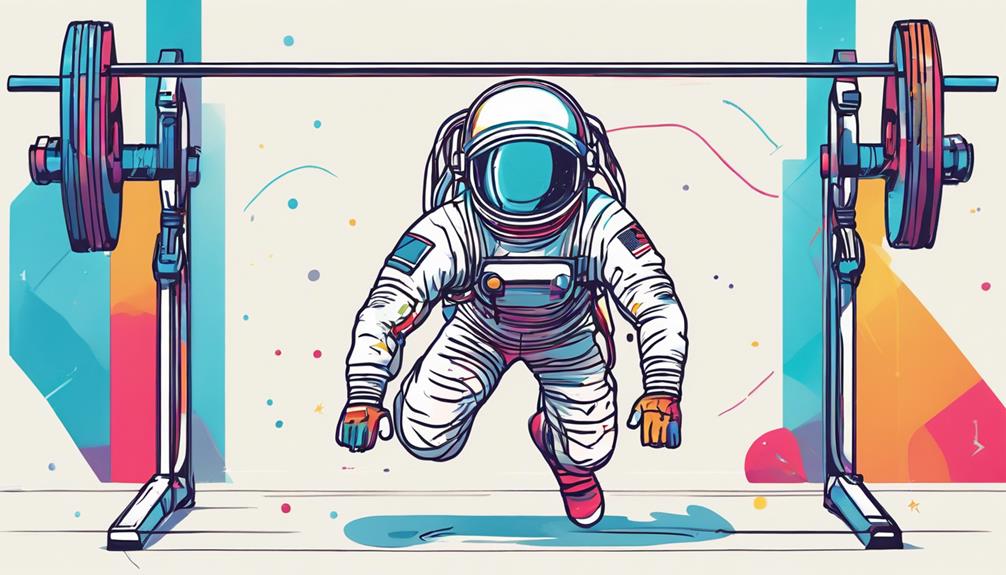
Achieving optimal physical fitness is a prerequisite for astronauts to endure the rigorous demands of space travel. NASA has set specific physical standards that candidates must meet to qualify for space missions. These standards encompass various aspects, including vision requirements, blood pressure limits, and height restrictions. Prospective astronauts undergo thorough medical evaluations to ensure they are in peak health and can withstand the challenges of space exploration.
In addition to medical assessments, candidates must also pass physical fitness tests to demonstrate their readiness for space missions. These tests evaluate various facets of physical health, such as cardiovascular endurance, strength, flexibility, and overall fitness levels. Meeting NASA's stringent physical fitness criteria is crucial for aspiring astronauts as it directly correlates with their ability to perform effectively in the unique environment of space.
Training Process for Aspiring Astronauts
Aspiring astronauts undergo comprehensive training programs at NASA's Johnson Space Center to develop the necessary skills and knowledge for space missions. This training is essential for preparing astronauts for the challenges they may face in space. The training process includes:
- Physical Fitness and Survival Skills: Astronauts undergo rigorous physical fitness training to ensure they can withstand the physical demands of space travel. Survival skill training equips them to handle emergencies that may arise during missions.
- Spacecraft Operation and Teamwork Exercises: Astronaut candidates learn how to operate spacecraft and work effectively as a team in a space environment. This training is crucial for successful missions where collaboration and coordination are key.
- Simulations: Astronaut training involves simulations that replicate real-life scenarios in space. These simulations help astronauts practice problem-solving, decision-making, and critical thinking skills in a controlled environment, preparing them for the unpredictable nature of space exploration.
Skill Sets Needed for Space Exploration
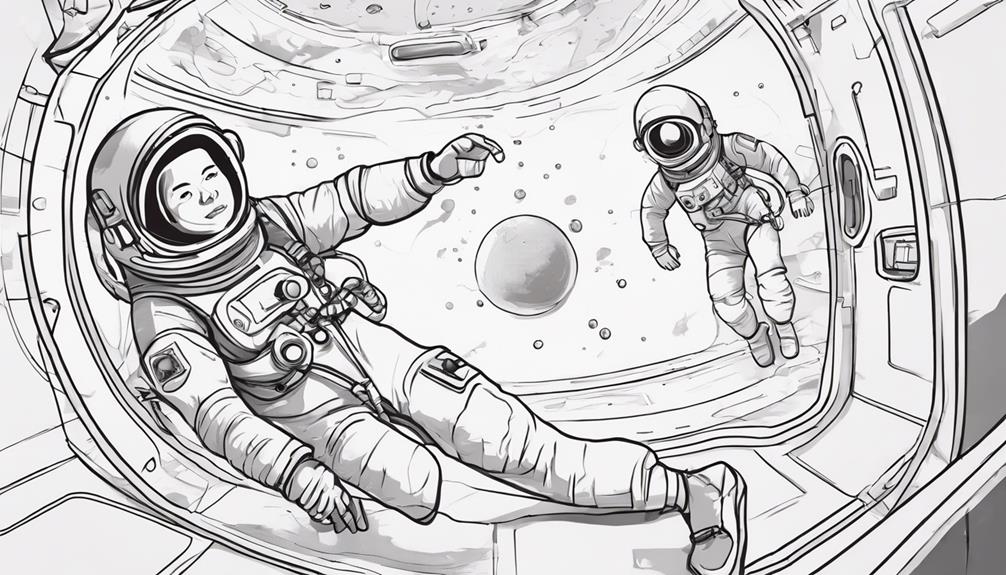
Astronauts embarking on space exploration missions require a diverse set of skills to navigate the challenges of extraterrestrial environments. These skills encompass technical proficiencies in fields such as engineering, biology, and computer science, as well as physical fitness criteria to withstand the rigors of space travel. Furthermore, mental resilience training is essential for astronauts to adapt, problem-solve, and excel under the demanding conditions of space exploration.
Required Technical Skills
Proficiency in a diverse range of technical disciplines is imperative for the successful execution of space exploration missions by astronauts. To excel in space missions, astronauts require the following technical skills:
- Engineering Knowledge: Understanding spacecraft systems and equipment, as well as the ability to operate and maintain them, is crucial for astronauts.
- Mathematical Proficiency: Proficiency in mathematics is essential for tasks like navigation, communication systems operation, and conducting experiments in space.
- Technical Problem-Solving Abilities: Astronauts must possess problem-solving skills, adaptability, and the ability to work in high-stress environments, along with the capability to utilize specialized tools and technology for research and experiments in space.
Physical Fitness Criteria
Physical fitness plays a crucial role in determining the readiness of individuals for space exploration missions. Astronaut candidates must meet specific height requirements, typically ranging from 5'2' to 6'3'. Good vision is essential, with the criteria stating that vision should be correctable to 20/20 in each eye. Cardiovascular health is a key focus, necessitating candidates to pass a rigorous physical exam to ensure they can withstand the demands of space travel. Below is a table summarizing the physical fitness criteria for aspiring astronauts:
| Physical Fitness Criteria | |
|---|---|
| Height Requirements | 5'2' to 6'3' |
| Vision Correction | 20/20 in each eye |
| Cardiovascular Health | Passing physical exam |
Endurance and strength training are vital components to maintain overall physical fitness and prepare for the challenges of space missions.
Mental Resilience Training
The comprehensive training regimen for space exploration missions extends beyond physical fitness assessments to encompass the cultivation of mental resilience through specialized skill sets.
Key Skill Sets for Astronaut Resilience Training:
- Problem-Solving Skills: Astronauts must be adept at finding solutions to unexpected challenges in the isolated and confined environment of space.
- Adaptability and Stress Management Techniques: Training focuses on preparing astronauts to adapt to changing circumstances and manage stress effectively during long-duration missions.
- Interpersonal Relationships and Teamwork Abilities: Building strong relationships with crew members, conflict resolution skills, and the ability to work effectively in a team are crucial for successful space exploration missions.
Astronauts undergo rigorous psychological evaluations, resilience training, and simulated mission scenarios to equip them with the mental fortitude needed for the demands of space travel.
Astronaut Candidate Application Process

Involved in NASA's astronaut selection process are multiple stages of rigorous evaluations and interviews to identify highly qualified candidates. NASA receives thousands of astronaut applications, with a record-breaking 18,300 applications in 2016. Among these applicants, highly qualified candidates are invited for interviews at the Johnson Space Center as part of the selection process. Approximately half of the candidates are then invited for second interviews to further assess their suitability. These interviews are crucial in determining the final candidates who will be chosen for training at the Johnson Space Center after a comprehensive evaluation process. The application process for becoming an astronaut involves various stages, including extensive evaluations and interviews to ensure that the selected individuals possess the necessary skills and qualities for space missions. Below is a table summarizing the astronaut candidate application process:
| Application Stage | Description |
|---|---|
| Initial Application | Submission of basic information and qualifications |
| First Interview | Evaluation of technical skills and experience |
| Second Interview | Further assessment of candidate suitability |
| Final Selection | Chosen candidates proceed to astronaut training |
Psychological Evaluation for Astronaut Candidates
A crucial component of NASA's astronaut selection process is the comprehensive psychological evaluation conducted on astronaut candidates to assess their mental health and readiness for the challenges of space missions.
- Evaluation of Mental Health: Psychological evaluations are essential to ensure that candidates possess the mental stability required to cope with the demands and stress inherent in space missions.
- Assessment of Problem-Solving Skills: These assessments aim to identify candidates with strong problem-solving skills, crucial for navigating unexpected challenges that may arise during missions.
- Resilience and Teamwork: Candidates must demonstrate the ability to work effectively in teams and handle isolation during long-duration space missions, highlighting the importance of psychological evaluations in selecting individuals capable of thriving in the unique environment of space exploration.
Career Opportunities Beyond Astronautics
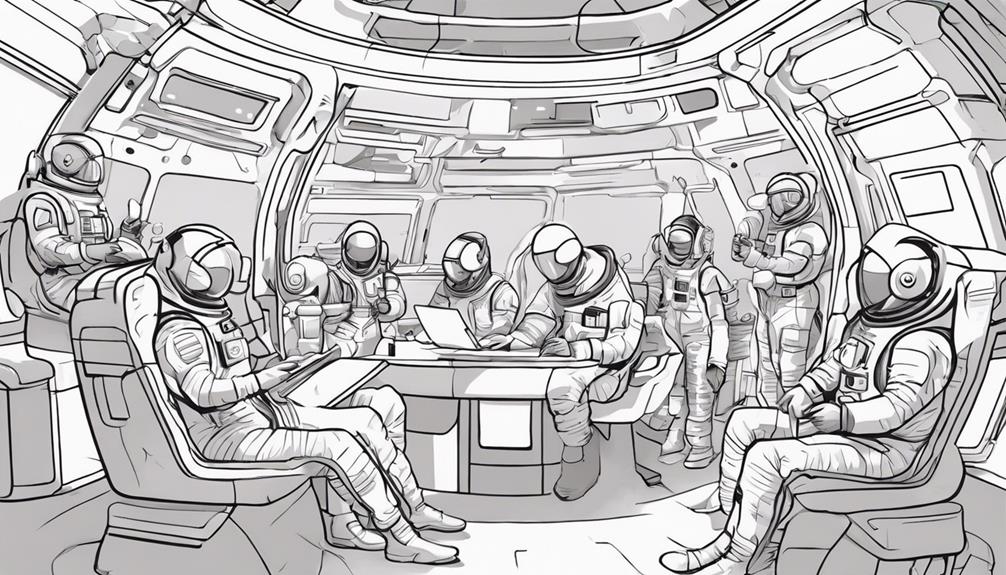
The field of space exploration offers a plethora of career opportunities beyond astronautics, catering to individuals with diverse skill sets and interests. Aerospace engineering, for instance, provides a crucial avenue for professionals to design innovative spacecraft and aircraft for space missions. Research institutions, universities, and space agencies like NASA present various roles in space exploration that extend beyond the realm of astronautics.
Diverse Space Roles
Professionals in the aerospace industry play pivotal roles in shaping the future of space exploration by contributing their expertise to various career opportunities beyond astronautics.
Diverse Space Roles:
- Aerospace Engineering: Designing spacecraft and aircraft for space exploration offers a diverse career path beyond astronautics.
- Research and Institutions: Opportunities in space travel exist in research institutions, universities, and organizations like NASA, providing diverse career options.
- Advancements in Space Exploration: Over 66,000 individuals worked as aerospace engineers in 2019, significantly contributing to advancements in space exploration.
Alternative Aerospace Careers
Within the aerospace industry, numerous career opportunities exist beyond the realm of astronautics for those seeking alternative paths in space exploration. Aerospace engineering, a key field in space exploration, offers various career paths such as designing spacecraft and aircraft for missions. Individuals can explore roles in research institutions, universities, and even at NASA, contributing to advancements in space travel. In 2019, there were over 66,000 aerospace engineers working towards pushing the boundaries of space exploration. These professionals play a vital role in designing and developing vehicles for space missions, highlighting the diverse career paths available for those passionate about space exploration.
| Aerospace Engineering Careers | Space Exploration Opportunities | NASA Positions |
|---|---|---|
| Spacecraft Design | Research Institutions | Aerospace Engineer |
| Aircraft Design | Universities | Mission Specialist |
| Systems Engineering | Private Space Companies | Scientist |
| Propulsion Specialist | Government Agencies | Data Analyst |
Salary Expectations for Astronauts
With salaries ranging from $66,167 to $161,141 per year, astronaut compensation is determined by experience and qualifications.
Salary Expectations for Astronauts:
- NASA Astronauts:
- NASA astronauts can earn a starting salary of $104,898 to $161,141 annually, with potential for bonuses based on performance.
- Military Astronauts:
- Military astronauts may receive additional pay determined by their rank and years of service, on top of their base salary.
- Commercial Astronauts:
- Commercial astronauts participating in private space missions may have varying salary structures depending on the specific company they work for.
Astronauts also enjoy additional benefits such as healthcare coverage, retirement plans, and exclusive access to specialized training programs. The dynamic nature of astronaut compensation highlights the importance of experience, qualifications, and the sector in which the astronaut operates.
Inspiring Future Generations to Reach for the Stars
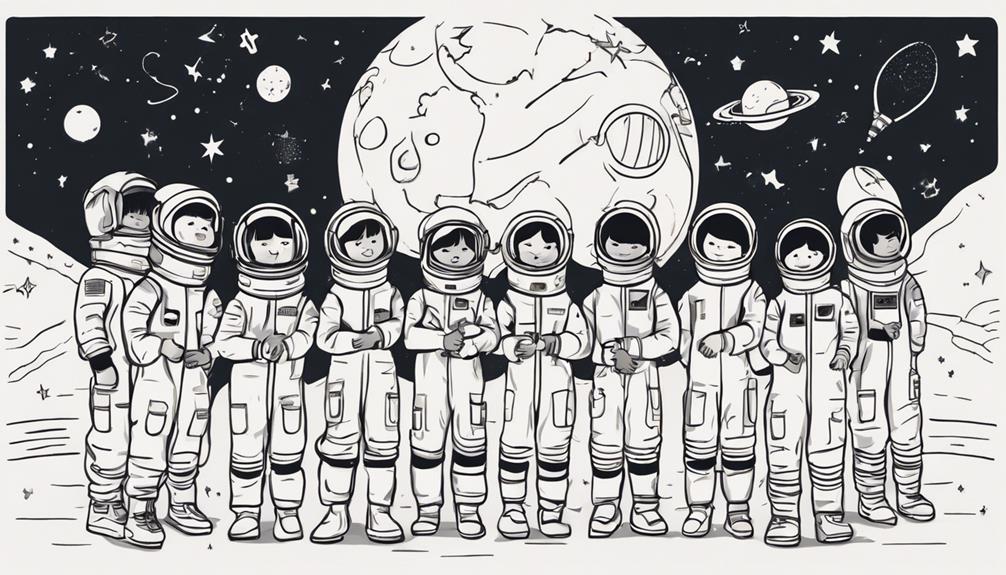
NASA's efforts to inspire future generations in space exploration are multifaceted, incorporating initiatives like encouraging STEM education, sharing astronaut stories, and providing hands-on space activities. By fostering an interest in science, technology, engineering, and mathematics, young minds are prepared to pursue careers in space exploration. Through these strategic approaches, the next generation is equipped with the skills and motivation needed to reach for the stars.
Encouraging STEM Education
Encouraging a robust STEM education foundation is paramount in cultivating the next generation's interest in space exploration and inspiring them to aspire to become astronauts.
Importance of STEM Education for Future Astronauts:
- Foundation for Excellence: STEM education equips aspiring astronauts with the necessary skills in science, technology, engineering, and math to excel in space-related fields.
- Igniting Passion: Hands-on STEM activities and programs play a crucial role in sparking a passion for space exploration among young individuals.
- Collaborative Initiatives: Collaborations between schools, organizations, and space agencies can enhance STEM education efforts, providing a comprehensive learning experience for future astronauts.
Sharing Astronaut Stories
Astronaut narratives serve as powerful catalysts, propelling future generations towards the celestial realms of space exploration. The stories of astronauts inspire young minds, showcasing the possibilities within the realm of space exploration and instilling a drive to reach for the stars. By learning about astronauts' journeys, individuals can see the dedication, resilience, and hard work required to achieve such extraordinary feats. These narratives not only spark curiosity and wonder about the universe but also emphasize the importance of education and training in pursuing a career in space exploration. Through sharing astronaut stories, a sense of aspiration is cultivated among aspiring astronauts, motivating them to pursue STEM fields and strive towards fulfilling their dreams of space exploration.
Hands-On Space Activities
Exploring hands-on space activities provides a tangible pathway for fostering a passion for space exploration among future generations, igniting curiosity and cultivating essential STEM skills.
Three Key Hands-On Space Activities:
- Participation in NASA's Space Camp: Offers immersive experiences for young aspiring astronauts, allowing them to engage in simulated space missions and astronaut training activities.
- Building Model Rockets: Provides a hands-on experience in rocketry, teaching students about aerodynamics, propulsion, and engineering principles.
- Programming Rovers: Allows students to work on robotics projects, honing their coding skills and understanding of autonomous systems used in space exploration.
Engaging in these activities not only inspires interest in space but also nurtures teamwork, problem-solving abilities, and a deeper understanding of the aerospace industry.
Frequently Asked Questions
How Long Does It Take to Become an Astronaut?
The journey to becoming an astronaut requires a significant time commitment, typically around a decade. This duration encompasses obtaining bachelor's and master's degrees, accumulating relevant experience, and undergoing basic training. Education requirements include expertise in STEM fields. Additionally, physical fitness is crucial as astronauts must demonstrate exceptional physical and mental readiness for the challenges of space exploration. The comprehensive preparation is essential before being selected for space missions.
How Difficult Is It to Become an Astronaut?
Becoming an astronaut demands meeting stringent criteria, extensive astronaut training, and exceptional physical fitness. Applicants must possess a STEM master's degree, relevant experience, and pass through a highly competitive selection process. Astronaut training is rigorous, focusing on spacecraft operations, survival skills, and spacewalks. Additionally, candidates undergo medical evaluations to ensure optimal physical health for space missions. The demanding requirements and intense competition underscore the difficulty in becoming an astronaut.
How Much Do Astronauts Get Paid?
Astronauts' salaries range from $66,167 to $161,141 annually, based on experience, military rank, and specific mission assignments. They are responsible for conducting experiments, maintaining spacecraft, and performing spacewalks. Career advancement opportunities for astronauts include progressing to higher ranks within the military or taking on leadership roles within NASA. Overall, astronaut pay is influenced by various factors, ensuring competitive salaries for individuals in this prestigious profession.
How Are Astronauts Selected?
The selection process for astronaut candidates is a highly competitive and meticulous procedure conducted by NASA. Candidates are chosen based on a rigorous assessment of their qualifications, skills, and aptitude for space exploration. Physical requirements are stringent, ensuring candidates possess the necessary physical stamina and health for space missions. Once selected, candidates undergo an intensive training program at the Johnson Space Center, equipping them with the knowledge and skills needed for space missions.
Conclusion
In conclusion, aspiring astronauts must meet stringent criteria in education, physical fitness, and skills to embark on space missions. The path to becoming an astronaut requires dedication, perseverance, and a commitment to excellence. As the saying goes, "Shoot for the moon. Even if you miss, you'll land among the stars," highlighting the ambition and determination needed to pursue a career in space exploration.
